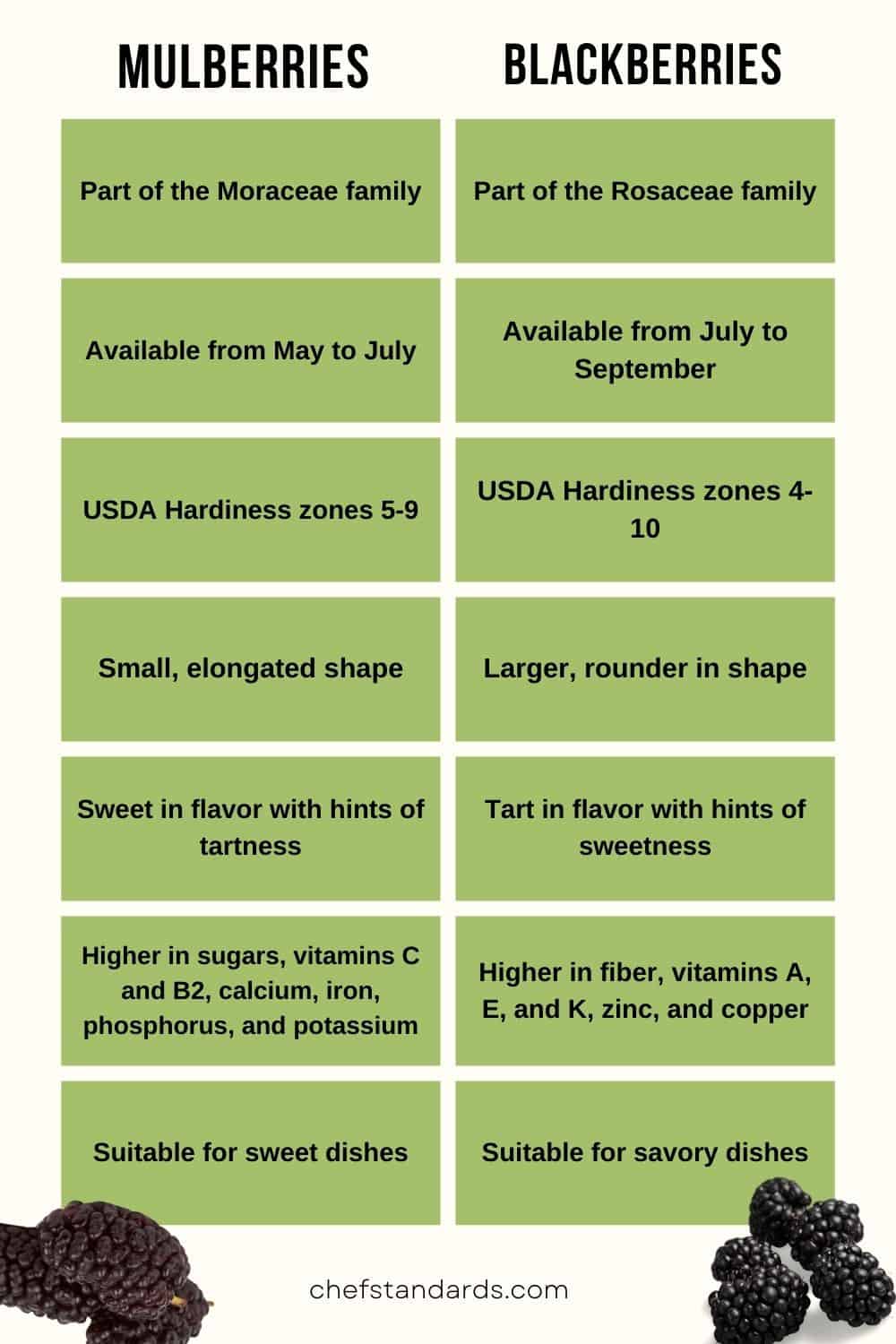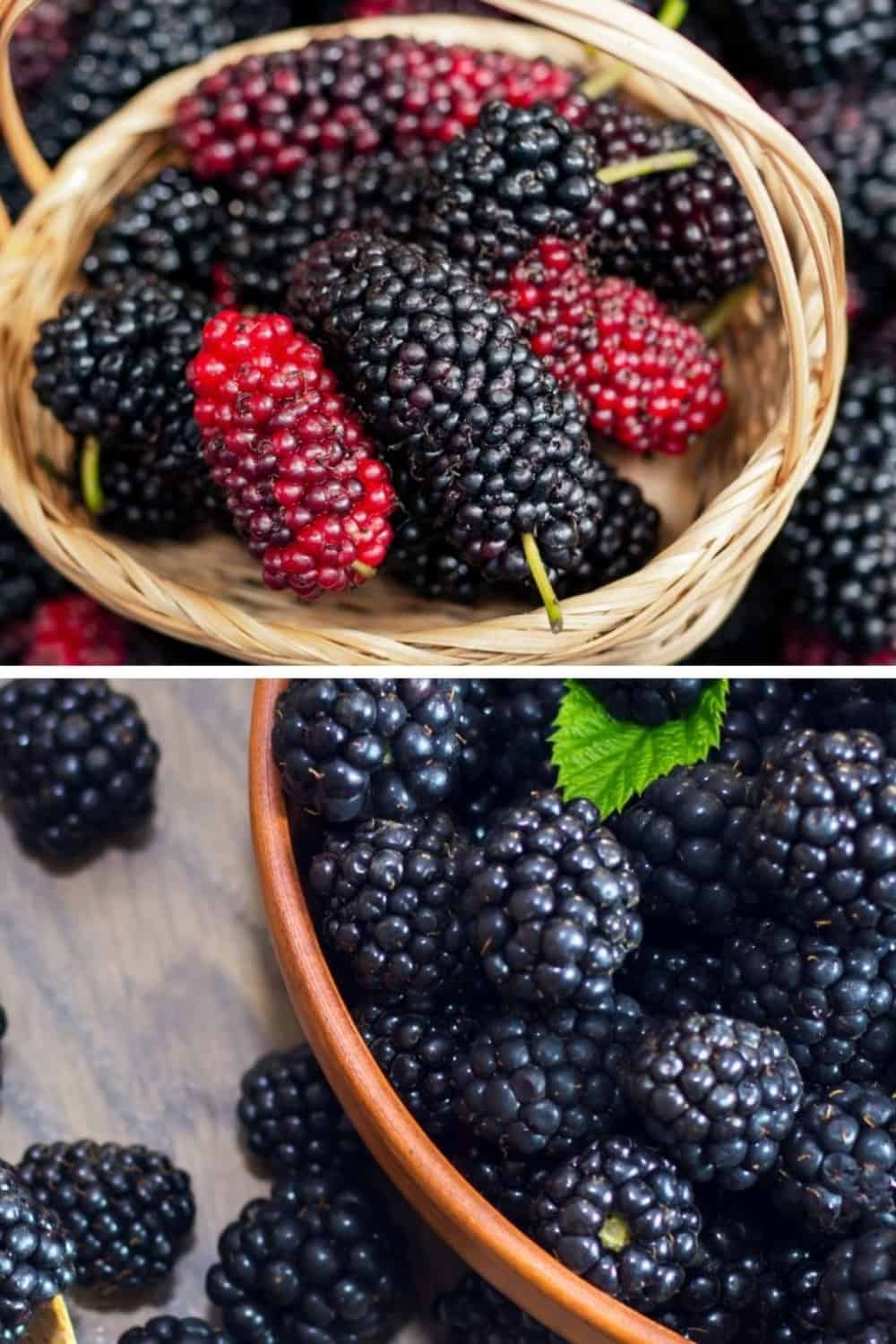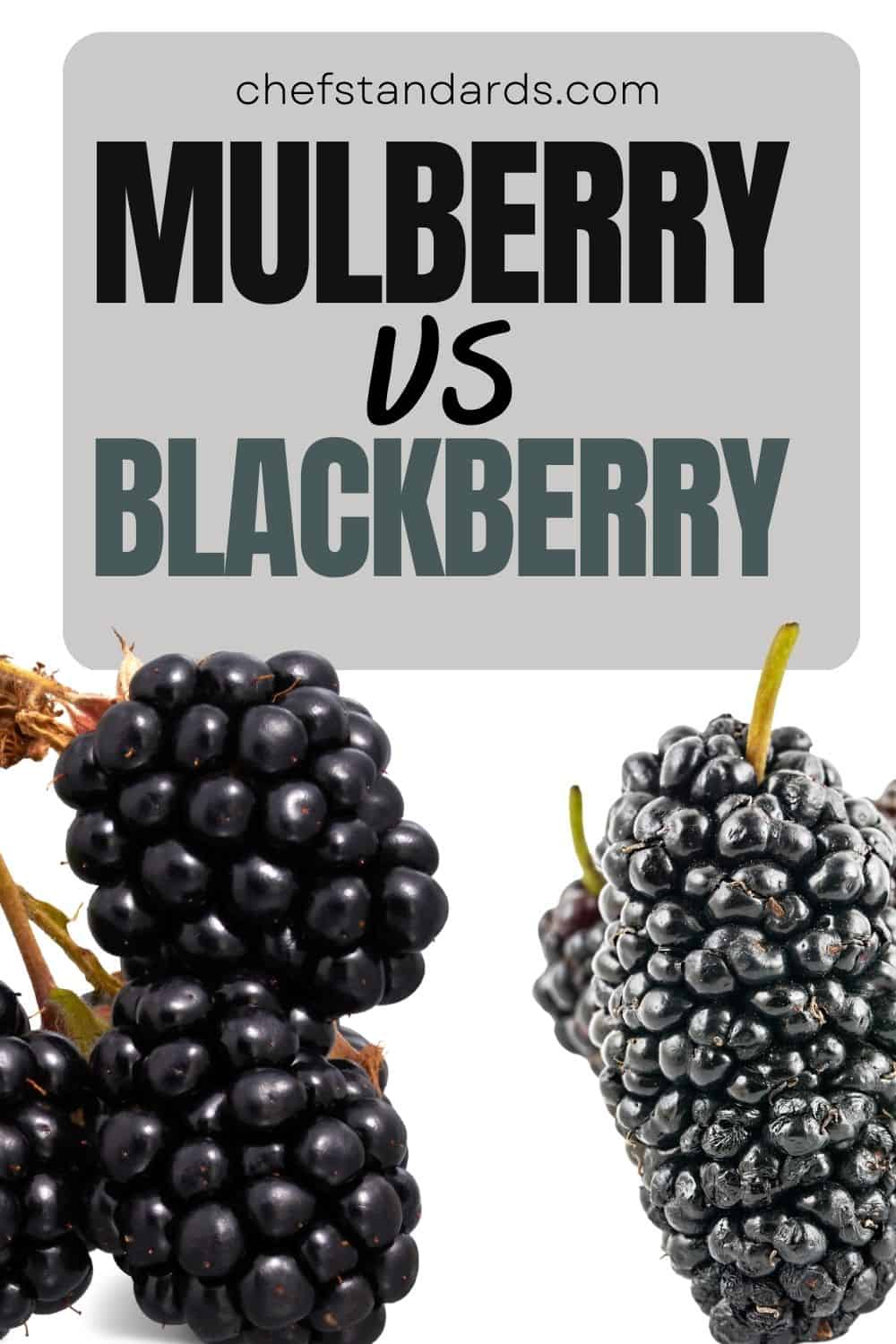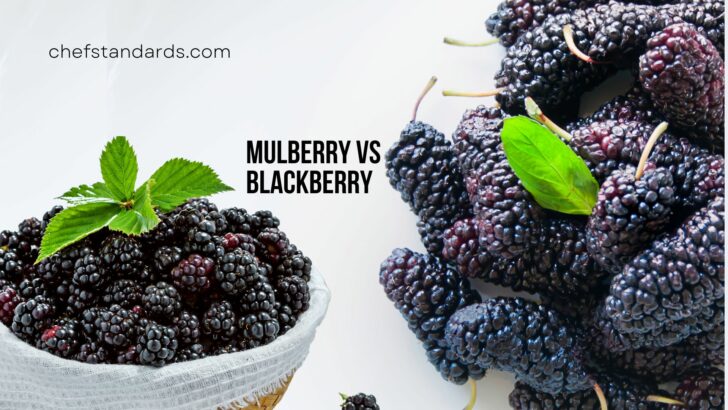I am sure that all of you have seen and tasted blackberries because they are quite common in the US. Namely, wild blackberries grow in many parts of North America.
Although they are not so common here, there is a probability that you have seen a specific berry that looks very similar to a blackberry. Most likely, you have seen the one known as a mulberry.
They are so much alike, but they also have some differences. The most noticeable difference between them is the fact that mulberries grow on trees, while blackberries grow on bushes.
But, there are also some differences in their classification, availability, appearance, flavor, texture, uses, and nutritional value, and it is not out of hand to know them.

Mulberries Vs Blackberries: Classification
As I already emphasized in the introduction part, mulberries grow on trees, while blackberries can be found on bushes. This fact alone tells us that their botanical classification is entirely different.
Mulberries
Starting with mulberries, they are a part of the Moracea family. This fruit that starts with m is the fruit of the mulberry tree, which is native to Asia but now grows in many parts of the world.
The scientific name for the mulberry tree is Morus spp., and there are many different species within this genus.
The three most common species used for their fruit are the white mulberry (Morus alba), the black mulberry (Morus nigra), and the red mulberry (Morus rubra).
One interesting fact about mulberries is that they are actually not classified as berries, despite commonly being called such. They are actually multiple or collective fruits.
This means that each fruit is actually formed from multiple different flowers that fuse together, rather than a single flower producing a single berry. Other examples of multiple fruits include figs, pineapples, jackfruit, and the osage-orange.
Blackberries
Blackberries, on the other hand, are a part of the Rosaceae family, which also includes other fruits like apples, raspberries, and strawberries.
The blackberry bush or blackberry plant is scientifically known as Rubus fruticosus, and it is a part of the Rubus genus within the Rosaceae family.
This plant is a perennial shrub that grows in many parts of the world, and it can be mostly found in North America and Europe.
The big surprise is the fact that neither blackberries are berries. In fact, they are actually classified as aggregate fruits.
In general, aggregate fruits develop from multiple carpels, the part of the flower that holds the seeds, from the single flower.
That is not a botanical definition of a berry as it is defined as a fruit that develops from a single ovary inside a single flower.
Surprisingly, many fruits that are not commonly referred to as berries, such as tomatoes, grapes, cucumbers, and bananas, are actually berries from the scientific point of view.
Season And Availability
The availability of both mulberries and blackberries can vary depending on the region and climate.
In some areas, mulberries and blackberries may be grown locally and sold at farmers’ markets or roadside stands, while in other areas, they are imported from other regions or countries.
However, there are some distinct differences between these two types of fruits in terms of season and availability.
Namely, mulberries are typically in season from late spring to early summer, usually from May to July, sometimes even through August, depending on the location.
They have a short growing season, which can sometimes make them difficult to find and more expensive, especially in the US.
Blackberries, on the other hand, have a longer growing season and are available for a longer period of time than mulberries. They typically ripen in mid to late summer, usually from July to September, depending on the location.
Also, they are more widely grown and commercially available than mulberries, which makes them more readily available and less expensive.
Hardiness Zones
Although this one is not very important to all people, gardeners, horticulturists, and farmers find it very beneficial to know what the suitable hardiness zones of both mulberries and blackberries are.
First, hardiness zones are a system used to classify geographic areas based on their average minimum temperatures in the winter, which is quite beneficial to know for these specific professions.
Starting with mulberries, they are generally hardy in USDA hardiness zones 5-9, which means they can survive in areas with minimum temperatures ranging from -20°F to 20°F.
They are more tolerant of cold weather than many other fruit trees, making them a good option for gardeners in cooler climates. However, they may not thrive in areas with very hot and dry summers, as they prefer a moderate amount of moisture.
When it comes to blackberries, they are hardy in USDA zones 4-10, which means they can survive in areas with minimum temperatures ranging from -30°F to 30°F.
This means they are more flexible than mulberries, i.e. they can thrive in colder environments, as well as in warmer and drier regions.
What Are The Differences In Their Appearance?

The biggest misunderstanding in distinguishing mulberries from blackberries comes from their similar appearance.
Both fruits grow similarly in shape and color, and this is especially the case if you see a black mulberry since it is quite similar to the blackberry.
Namely, blackberries come in different colors, including white, purple, black, and red, while blackberries come in only one color – dark purple hue.
Logically, black mulberries and blackberries are most similar in appearance. One type of black mulberry is the “Teas Weeping” mulberry and it looks very similar to a blackberry.
Another type is known as “Black Beauty”, and it has a similar color, but is bigger than the blackberry, so it can be said that it looks like an extra-large blackberry.
When it comes to shape, they are quite different. Namely, mulberries are usually smaller than blackberries and are elongated in shape, whereas blackberries are larger and rounder.
How To Distinguish Their Flavor Profiles?
I’ve tried both of these “berries” and I can fairly say that they have similar flavors. However, one flavor is more pronounced in one type of “berry” and vice versa.
The first thing you can notice in mulberries when it comes to flavor is that they are quite mild, but the sweet flavor is quite pronounced, and there are also hints of tartness.
From my own experience, I would describe the taste as a cross between a grape and a raspberry.
Although I have never tried them, I also know that some varieties of mulberries have a slightly nutty flavor, but they are not so common.
In terms of texture, they have a soft, delicate texture that can be described as slightly juicy and grainy.
Blackberries, on the other hand, have a predominantly tart flavor with a hint of sweetness, and I would describe it as more intense than that of mulberries. The level of acidity is somewhat similar to the level of acidity in blueberries.
The texture is a bit firmer than that of mulberries, with a slightly rough exterior that gives way to a juicy, seed-filled interior.
I prefer blackberries because they have a more “berry-like flavor” and I find them more appealing to eat on their own.
Mulberries are sweeter indeed, but when eating them, it tastes more like some type of very sweet vegetable, so I prefer to use them in combination with some other berries or for making some type of sweet jam.
What About Their Nutrition And Health Benefits?
Berries in general are considered to be one of the healthiest foods out there, and mulberries and blackberries are no exception.
Both of these fruits are very high in phytochemicals and antioxidants, and that is their greatest quality when it comes to nutrition and health.
Although the antioxidant content is quite similar, there are some differences and I will emphasize just a few of the important ones.
Namely, mulberry fruits, especially black mulberries, have higher levels of phenolic and flavonoid compounds, when compared to blackberries.
Also, the overall antioxidant capacity of black mulberries is slightly higher when compared to other types of mulberries, as well as blackberries.
One important antioxidant known as resveratrol, is found in high amounts in both mulberries and blackberries.
Resveratrol is a very strong antioxidant since it can fight inflammation and help with various cardiovascular conditions.
There is a lot more to say about antioxidants in these two fruits, but I won’t go into too much detail. All in all, both are high in antioxidants, but black mulberries are slightly more potent.
When it comes to vitamins and minerals, it is easier to distinguish between these two. Although they are quite similar in this as well, there are some differences.
Mulberries have a higher amount of sugar, vitamin C, vitamin B2, calcium, iron, phosphorus, and potassium.
In fact, one serving of mulberries is enough to fulfill about 85% of recommended daily intake of vitamin C.
Blackberries, on the other hand, contain more fiber, vitamin A, vitamin E, vitamin K, zinc, and copper.
One serving of blackberries has 30% of the recommended daily intake of fiber.
Although lower in vitamin C compared to mulberries, blackberries still have a decent amount, i.e. one serving is enough for about 50% of the recommended daily intake of vitamin C.
If you want to know more about the nutritional profiles of mulberries and blackberries, a nutrition table is below.
Mulberries and blackberries nutrition facts based on 1 cup serving (144g):

Different Uses Of Mulberries And Blackberries
Since they have a similar flavor and are both “berries”, mulberries and blackberries can also be used in the same types of dishes and for similar culinary purposes.
However, there are some types of dishes that are more suitable for one type of “berry” and vice versa, so I think that needs to be discussed.
First, you can use both mulberries and blackberries for baked dishes, such as cakes, muffins, and pies. However, it is always better to choose blackberries because mulberries have a softer texture, so it can be more challenging to incorporate them into your recipes.
You can also use them to add some extra fruity and sweet flavor to your gluten-free banana pancakes.
Another popular way to use these two fruits in your kitchen is to use them in the sauce. However, you should know that blackberries are much more suitable for savory sauces due to their tart flavor.
Mulberries are more commonly used in sweet sauces and the reason is obvious.
Making jam with berries is one of the most popular things you can do if you want to enjoy a healthy and sweet spread. Although you can make jam from mulberries, blackberry jam is much more popular and it is usually made only from blackberries.
When mulberries are used for making jam, they are most commonly used in combination with other berries, although mulberry jam alone is sometimes used as a condiment with cheese.
One of the most popular ways to use mulberries and blackberries is for beverages, such as smoothies, cocktails, and teas. Mulberries can also be used to make mulberry wine, which is quite popular in some regions.
Finally, you can eat both of these fruits as a snack. Blackberries are often enjoyed fresh or added to yogurts, salads, and granola. Mulberries can also be eaten fresh, but they are often dried and eaten as a snack, similar to cranberries.
Are Mulberries And Blackberries Interchangeable?
Mulberries and blackberries have different flavors and textures, so they may not be the best substitutes for each other in cooking. However, if you do not have blackberries and need a substitute, mulberries can be used in some recipes with a few adjustments.
Mulberries are softer and juicier than blackberries, so they may break down more easily when cooked. This means that they may not hold their shape as well in baked goods like pies or cobblers.
To counteract this, you can try adding a thickener like cornstarch or tapioca starch to the filling.
In terms of flavor, mulberries are sweeter with less tartness than blackberries, so you may need to adjust the sweetness in the recipe. You can also try adding a little lemon juice or zest to the recipe to mimic the tartness of blackberries.
Overall, while mulberries can be used as a substitute for blackberries in some recipes, it is important to keep in mind the differences in flavor and texture and make adjustments accordingly.


